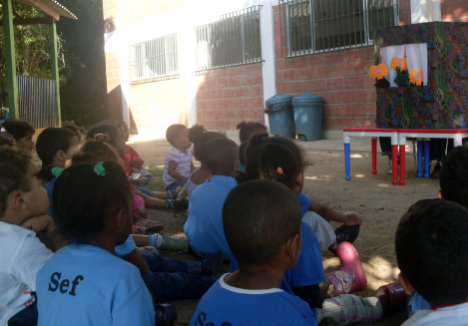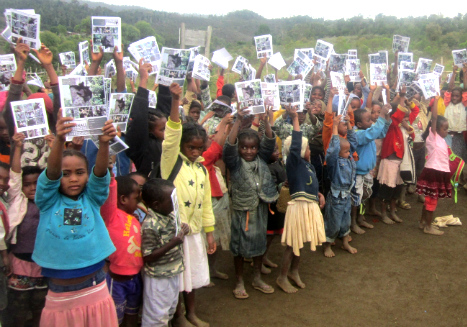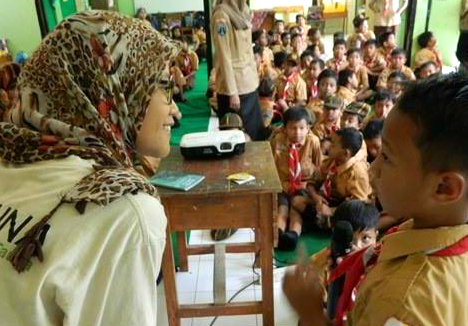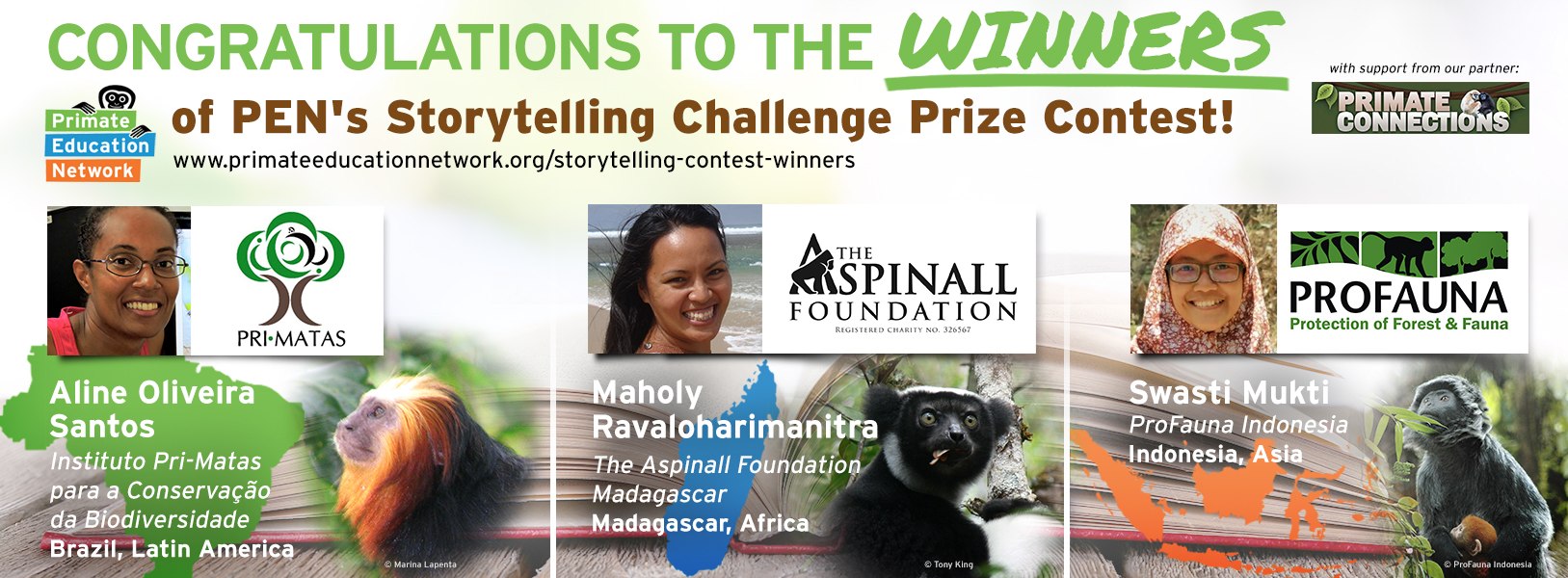We are proud to announce and congratulate the finalists of our Storytelling Challenge Prize Contest. The winners are Aline Oliveira Santos, Maholy Ravaloharimanitra, and Swasti Mukti! They will be awarded $250 USD (with support from Primate Connections) for their primate education efforts.
Aline, Maholy, and Swasti are working in different countries, but are applying similar methods to change the hearts and minds of the communities they educate. Their experiences demonstrate how storytelling, the oldest form of education, can help you achieve your conservation goals.
Primate Education Network (PEN) received traditional and contemporary stories from educators working across the globe for our contest. We would like to commend all of our colleagues for sharing their successes in applying the art of storytelling to positively influence knowledge, attitudes, and behavior of communities in primate range countries. Learn more about storytelling and our contest details.
PEN’s Regional Coordinators in Latin America, Africa, and Asia conducted the interviews and transcribed and translated the contest entries. Our team evaluated each project’s success in providing clarity and context (i.e. the characters, setting, plot, conflict, and resolutions of their stories), solving specific conservation problems, integrating stories into education programs, and helping fellow educators learn from their experience in using storytelling as an effective tool for education.
Meet PEN’s three contest winners and read their stories below!
Aline Oliveira Santos, Instituto Pri-Matas para a Conservação da Biodiversidade
Brazil, Latin America

Puppet Theater © Instituto Pri-Matas para a Conservação da Biodiversidade
- Aline’s Interviewer: Patricia Mie Matsuo, PEN Regional Coordinator for Brazil
- Type of Story: Nonfictional oral, written, and enacted modern story
- Source / Authors: © Aline Oliveira Santos, Susie de Jesus Rodrigues Pinto, and Maria Cecília Martins Kierulff
- Methods of Delivery & Target Audience:
- Puppet theater (Kindergarten and 1st grade elementary students)
- Storytelling flannel board (2nd - 5th grade elementary students)
- PowerPoint presentations (Older students)
- Guided discussions (Adults)
- Brochure that encourages communities not to feed tamarins and to call researchers when the tamarins are in the area (Teachers, condominiums / households, institutions, firefighters, and veterinarians)
At our project location in Brazil, there was a school employee who used to give food to the tamarins. She cried after listening to our story and learning about the importance of returning tamarins to their native habitat. Our story had a profound effect on her behavior.
Summary of Story
Aline’s story is a factual story about a golden headed lion tamarin family’s capture, trauma, and triumphant return to the forest in Brazil’s Bahia State. With several familiar characters, including a hunter, children, parents, and researchers, this story communicates a real and present danger in a memorable way.
Full Story
Once upon a time, there was a group of golden headed lion tamarins living in a beautiful forest in Brazil’s Bahia State. They were happy in their natural habitat living among many other animals. When suddenly, a parrot made an alarm call in the forest in response to a hunter. All of the animals began to run, jump, and fly. Only a pair of golden headed lion tamarins stayed and were captured by the hunter. They were very frightened because they had never been in a cage. This was the first time they had ever been in a cage. The hunter realized that they were very agitated, so he gave them a sedative to stay quiet. The hunter took them to a market. In the market, a tourist couple saw the tamarins and decided to buy and take them home. These tourists were from Niteroi city in Rio de Janeiro State. They took the tamarins to their home and gave them to their children. The children liked the tamarins’ golden color. They wanted to play with the tamarins, but the tamarins didn’t want to play; they were frightened. The effects of the sedative had worn off and the tamarins became a little aggressive. The children could tell that the tamarins wanted to get out of the cage, so they asked their parents if they could release them. The parents decided to take the tamarins to the forest near their house and release them.
The tamarins found the forest very different from their homeland. The trees were smaller and the animals they knew were not there. One day, the forest became even smaller as trees were cut down. The tamarins were worried about the situation and decided to move closer to the houses at the edge of the forest. The people who lived in the houses liked the tamarins and gave them food, so the tamarins began to eat that food. The tamarins stayed close to the houses, had babies, and their families grew.
The babies grew up and increased the population of tamarins in the Niteroi forest. After a while, a group of researchers became concerned about the situation. They knew that the tamarins were not native to the forest; they were from the forest in Bahia. The researchers counted the tamarins living in Niteroi, and they found 15 families of golden headed lion tamarins. They were worried that the tamarins were living in a different forest and in a place close to the area where golden lion tamarins, another threatened species, live. They were also worried that if these two monkeys met, reproduction could happen between the two types of tamarins.
The researchers decided to take the golden headed lion tamarins group back to Bahia. They succeeded in capturing a whole family of golden headed lion tamarins using live-traps with bananas as bait. The researchers took the tamarins to a location to be studied – the Rio de Janeiro State Primate Center. At the center, the researchers examined the tamarins to see if they were healthy to return to their native forest, making sure they would not transfer any diseases to the other animals in Bahia. Everything was fine with the tamarins, so they took the first tamarin family back to Bahia. When the tamarins arrived back in Bahia, they were released in the forest very early in the morning. They looked around and realized they were in another forest. The trees were larger. There were more animals. They found more food in the trees. And they began to recognize that it was the forest where they had lived before. They were very happy. Much like this tamarin family, other families are also being captured in Niteroi and taken back to Bahia, their homeland. And so ends our story.
Download the Full Story in Portuguese
How Aline Will Use Her Prize: Aline will use her prize to purchase puppet theater and storybook supplies, print evaluation materials, and cover transport costs to reach schools surrounding the União Biological Reserve (Reserva Biológica União).
Learn More: Read Instituto Pri-Matas para a Conservação da Biodiversidade’s Profile and connect with Aline on PEN’s Projects Directory.
Maholy Ravaloharimanitra, The Aspinall Foundation Madagascar
Madagascar, Africa

Indri Notebooks © The Aspinall Foundation Madagascar
- Maholy’s Interviewer: Silver Birungi James, PEN Co-Regional Coordinator for East Africa
- Type of Story: Fictional oral traditional story
- Original Source / Author(s): Unknown
- Maholy says, “When told orally, the story is usually slightly modified according to the storyteller and their storytelling style.”
- Methods of Delivery & Target Audience: Orally and through the distribution of posters (Schoolchildren below 10 years of age)
Storytelling targeted for children also has an impact on their parents and other adults of the community in Madagascar because they share what they learn with them.
Summary of Story
Maholy’s story is a folktale about a boy and his father who go to the forest to collect wild honey. They encounter a dangerous situation and a lemur arrives to save the day!
Full Story
Once upon a time, when the forest was still rich and pristine, little Koto went into the forest with his father to hunt and collect wild honey. They were lucky to find some quarry, but they had yet to locate a hollow tree with a bee nest. It was difficult to find the bees, as it wasn't the right season for them because the forest was damp and chilly. Finally, Koto's father spotted a bee nest very high up in a tree. Koto was afraid to climb up there because it looked dangerous, but his father said that they would have to go home without any honey if they didn't try.
So Koto followed his father, as he began to climb the tree. At first it was easy, but the higher they got, the more frightened Koto became. Suddenly, just before they reached the bee nest, the branch on which the two were standing on bent and broke. Koto watched in horror as his father fell to his death.
Koto was injured and scratched by branches as he fell down. When he hit a thick branch with his leg, he could feel that his bone was broken. Then, he hit another branch with his head and passed out. Luckily, Koto was lightweight, so the branches had cushioned his fall.
After a while, Koto regained consciousness. The first thing he saw when he opened his eyes was a big animal with soft fur, soft eyes, and tender human-like hands. Koto felt these hands comfort him, treat his injuries, and give him food and water. Over the next few weeks, the animal did not leave Koto's side. He cared for him until he fully recovered.
Finally, the animal seemed to notice that Koto's leg had healed and that he was now strong enough to return to his village. The animal carried him on its back and leapt with him from tree to tree with huge jumps until they reached the forest edge where they could see Koto's village. There, he put Koto down on the ground and directed him to go there. Koto thankfully watched the animal return to the forest with big leaps, as he returned to his village.
When he arrived in the village, his family and neighbours were bubbling over with joy because they did not expect to ever see Koto alive again. But they were also very saddened to hear about the death of Koto’s father. When Koto told his story about the animal that saved his life, the villagers were very thankful. "You have found a second father", they said. Ever since, the furry animal with the human-like hands that saved Koto's life was called "Baban'i Koto", which means Koto's father. Koto told his family and neighbours that this animal shall never be hunted, trapped, or killed. All of their descendants have respected this instruction until today. And from time to time, the indri calls of the descendants of Koto's second father can still be heard in the village.
Download the Full Story in Malagasy
How Maholy Will Use Her Prize: Maholy will use her prize to cover transport to deliver lessons on lemur conservation for primary schoolchildren and teachers at Sakalava I, Sakalava II, Antsalohy, Nangaranana, Sahanomana, and Ranomainty. With support for her salary, she will enter post-questionnaire data from students and evaluate the results from her project’s talent show and drawing. She will also print primate education materials, including lemur posters, masks, storybooks, and drawing materials.
Learn More: Read Aspinall Foundation Madagascar’s Profile and connect with Maholy on PEN’s Projects Directory.
Swasti Mukti, ProFauna Indonesia
Indonesia, Asia

Primate Film © ProFauna Indonesia
- Swasti’s Interviewer: Thirza Loffeld, PEN Regional Coordinator for Sulawesi and Java
- Type of Story: Fictional oral and enacted traditional story
- Original Source / Author(s): Unknown
- Methods of Delivery & Target Audience: Puppet theater (Elementary schoolchildren from three to seven years of age)
Stories don't have to be classic folktales. We can make them up using our vast imagination. I often adapt my stories using the name of a forest or river near the village of the school I visit in Java, so my students can relate to them more easily.
Summary of Story
Swasti’s story is a fairytale about two princesses who compete to replace their father as the ruler of the kingdom. A langur’s transformation helps one princess win!
Full Story
Once upon a time, there was a kingdom in West Java. The king and the queen had seven daughters; five of them were married except the oldest and youngest of the sisters. When the king grew old, he often felt wistful because he needed to immediately appoint his successor. He could just choose the oldest daughter, Purbararang, but he hesitated as the oldest princess had a vile disposition, unlike the amicable youngest princess, Purbasari.
At last, the king chose Purbasari to replace him. Knowing this, Purbararang was angry because she was looking forward to becoming the ruler of the kingdom, along with her fiancé, Indrajaya. Together, they set up a wicked plan to get rid of Purbasari. They put poison in Purbasari’s meal, which made her get ugly rashes all over her body. Under Purbararang’s persuasion, the king sent Purbasari to exile in a forest. Purbasari willingly accepted the trial and stayed in a hut built by one of the king’s vices.
In the forest, Purbasari’s kindness attracted all the animals and they lived happily. Among the animals, Purbasari was closest to Lutung Kasarung (a langur monkey). It turned out that Lutung was actually a prince who was punished by the heaven due to his misdemeanor. They became close friends right away.
One day, Lutung meditated and prayed to the Gods in heaven for a cure to Purbasari’s disease. Suddenly, a lake appeared in the middle of the forest. Once Purbasari bathed in the lake, she recovered from her disease and got her beautiful features back. One day, the king’s vice returned to check on her. And seeing that Purbasari had recovered, he brought her back to the kingdom, along with Lutung.
Purbasari’s return was celebrated by everybody, except Purbararang. To prevent the king from appointing Purbasari as his successor, Purbararang asked her father to hold competitions to determine who should be the next ruler of the kingdom. The king agreed.
The king held a cooking competition. Purbararang was assisted by the palace’s cooks, while Purbasari’s only companion was Lutung. Purbararang was almost finished, when Purbasari started to panic. Lutung then summoned the nymphs from heaven to help Purbasari. Purbasari finished the cooking in time and according to the jury, Purbasari’s cooking was more delicious than Purbararang’s.
Purbararang convinced the king to have another competition. This time, the king asked both princesses to let their hair down to see who had the longest hair. Purbararang took down her bight and her hair fell as far as her calf. Purbasari was anxious because she knew that her hair was not that long. Again, Lutung prayed to the Gods to help Purbasari. To Purbasari’s surprise, when she let her hair down, it reached her ankle!
Losing the fight for the second time, Purbararang became furious. She insisted that the king choose the daughter who had the most handsome fiancé. Purbararang was confident because no man in the kingdom could be more handsome than her fiancé, Indrajaya. Purbasari was dispirited because she did not have a fiancé. This time, Lutung prayed harder than before, begging the Gods in heaven to condone his past mistakes and return him to his original state. The Gods granted his wishes, and all of a sudden Lutung transformed from a monkey into a handsome young man named Guruminda, who descended from heaven. Everyone agreed that Guruminda was far more handsome than Indrajaya.
The king would not listen to Purbararang’s protest anymore, and he declared that Purbasari and Guruminda would replace him and the queen as the rulers of the kingdom. Everyone celebrated this good news!
Download the Full Story in Indonesian
How Swasti Will Use Her Prize: Swasti will use her prize to provide educational materials, including children’s books, posters, and more to ProFauna’s new project location at the Yang Highlands Wildlife Reserve, East Java. Our prize will also support schools in the village near the reserve.
Learn More: Read ProFauna Indonesia’s Profile and connect with Swasti on PEN’s Projects Directory.
Please join PEN and our partner Primate Connections in congratulating Aline, Maholy, and Swasti by commenting in this blog post and on our Facebook page.








